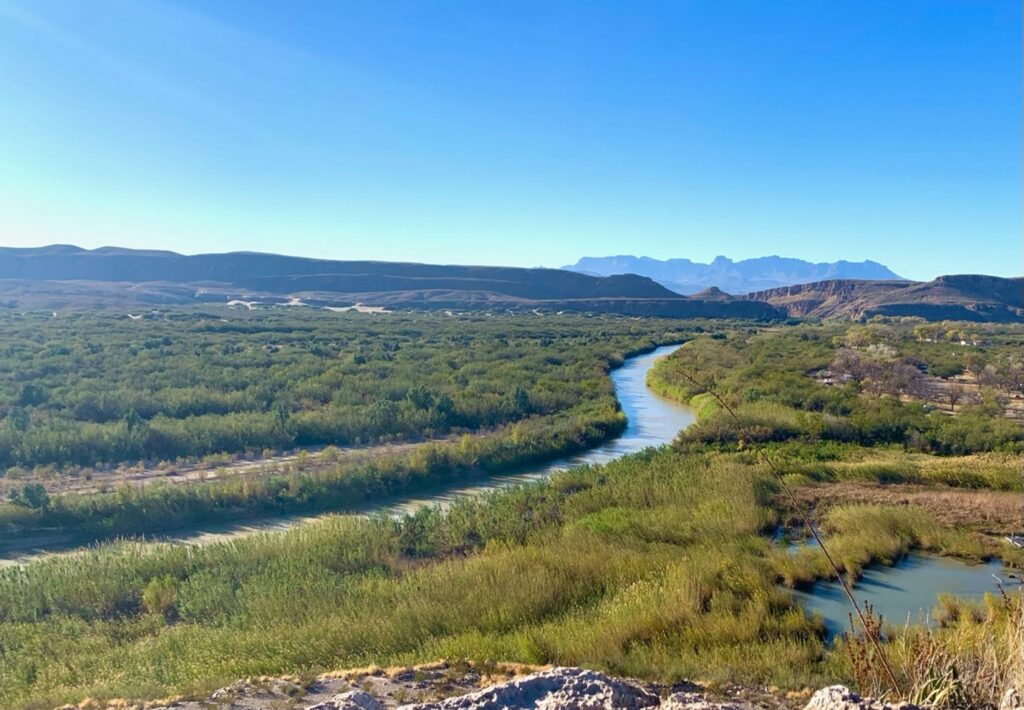
By Jaime Villareal, Jr., Spring 2022 Environmental Clinic Student
At the intersection of environmental and international law, lies the Rio Grande in Deep South Texas. For many, the Rio Grande Valley, or simply the RGV, – the southernmost region of Texas named after the 1,885-mile river that divides the United States and Mexico in Texas – is unassuming, yet it is filled with some of the richest culture, community, and food that can be found anywhere. Brownsville, Texas, my hometown and the largest city in the RGV, saw over 10 million international border crossings by car, foot, or commercial truck in 2017 alone. It is easy to take the international cooperation needed to accomplish this massive movement of people for granted. I would venture to say, however, that of the millions that cross the US/Mexican border in Texas yearly, very few realize the complicated international cooperation needed to govern the water that flows just below their vehicles.
Two international agreements govern the sharing of water in the Rio Grande – the 1906 Convention and the 1944 Water Treaty. Through these agreements, the United States and Mexico have pledged to share the waters of the Rio Grande. Under the 1944 Treaty, the United States must deliver 1.5 million acre-feet of Colorado River water into the Rio Grande annually. Conversely, Mexico is only required to deliver 1.75 million acre-feet of water over five years, which averages 350,000 acre-feet per year.
While the United States has consistently met its obligations under the 1944 Water Treaty, Mexico has failed to deliver its water obligations at least three times since 1992, to the detriment of the Texas farming and agricultural industry. During the 2010–2015 cycle, Mexico failed to deliver more than 260,000 acre-feet of water owed to the United States. During the most recent five-year cycle, Mexico nearly defaulted on its delivery obligations yet again but released reserves at the last minute. For the current cycle, Mexico is on track to defaulting once again. Between October 2020 to March 2022, Mexico has only delivered about 18% of the water that the United States expects to receive in one year.
While adequate for its time, the 1944 Water Treaty has since become antiquated and ambiguous and must be updated to meet 21st century standards. When Mexico fails to meet, or it anticipates it will not be able to meet, its water delivery obligations, it usually justifies its actions by claiming it is experiencing an extraordinary drought. In fact, much of the controversy stems from ambiguity of the term extraordinary drought; what constitutes an extraordinary drought; and how to proceed if there is, in fact, an extraordinary drought. While the Treaty does not define the term ‘extraordinary drought,’ Article 24(d) provides a framework for dispute resolution. When a dispute arises, the Treaty calls on the International Boundary and Water Commission to settle all differences. If the IBWC cannot resolve those differences, both countries must address the dispute through diplomatic channels. In today’s political and global world, however, this process – when invoked – rarely gets the job done, and tensions between officials on both sides of the River remain high.
Given the drought that parts of Southern Texas and Northern Mexico have experienced over the last few decades compounded by the effects of climate change, there is simply not enough water to meet demand and obligations required by the 1944 Treaty. The Treaty must be renegotiated and updated. At a minimum, the Treaty should place a greater emphasis on the role of climate change and enact measures to address water scarcity to allow for the equitable sharing of the important Rio Grande in the spirit of international cooperation.
The articles published on this site reflect the views of the individual authors only. They do not represent the views of the Environmental Clinic, The University of Texas School of Law, or The University of Texas at Austin.
